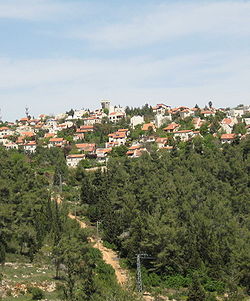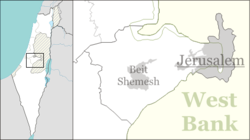Har Adar
Har Adar
|
|
|---|---|
 |
|
| Coordinates: 31°49′34″N 35°07′47″E / 31.82611°N 35.12972°ECoordinates: 31°49′34″N 35°07′47″E / 31.82611°N 35.12972°E | |
| Region | West Bank |
| District | Judea and Samaria Area |
| Founded | 1982 |
| Government | |
| • Type | Local council (from 1995) |
| • Head of Municipality | Aviram Cohen (since 2004) |
| Area | |
| • Total | 994 dunams (99.4 ha or 246 acres) |
| Population (2015) | |
| • Total | 3,858 |
| Name meaning | Mount Adar |
Har Adar (Hebrew: הַר אֲדָר) is an Israeli settlement and local council in the Seam Zone and the Maccabim sub-region of the West Bank. Founded in 1982, it had a population of 3,858 in 2015. It is located near Abu Ghosh and the Green Line on Road 425, approximately 15 kilometers west of Jerusalem. Har Adar is ranked high on the Israeli socio-economic scale, at 9/10.
The location of Har Adar was named Radar Hill (Hebrew: גִּבְעַת הָרָדָאר, Giv'at HaRadar), for the World War II British military installation there which had an anti-air radar for the protection of Jerusalem. The installation was handed over to the Jordanian Arab Legion on May 10, 1948, prior to the second phase of the 1948 Arab-Israeli War. 23 attempts by the Palmach's Harel Brigade to conquer it failed, although the Jewish force held the position for four days starting May 22, 1948. It was finally captured in the Six-Day War by the Harel Brigade. A monument for the fallen soldiers of the brigade stands at the top of the town.
The current settlement was founded in 1982 by the Radar Hill Organization. Har Adar (lit. The Radar or Mount Adar ) was a similar-sounding Hebrew name given to the hill and the settlement.
In 2009, the population of Har Adar was 99.3% Jewish, with a more or less even distribution of men and women (1,700 men and 1,600 women). The age distribution was as follows:
...
Wikipedia

